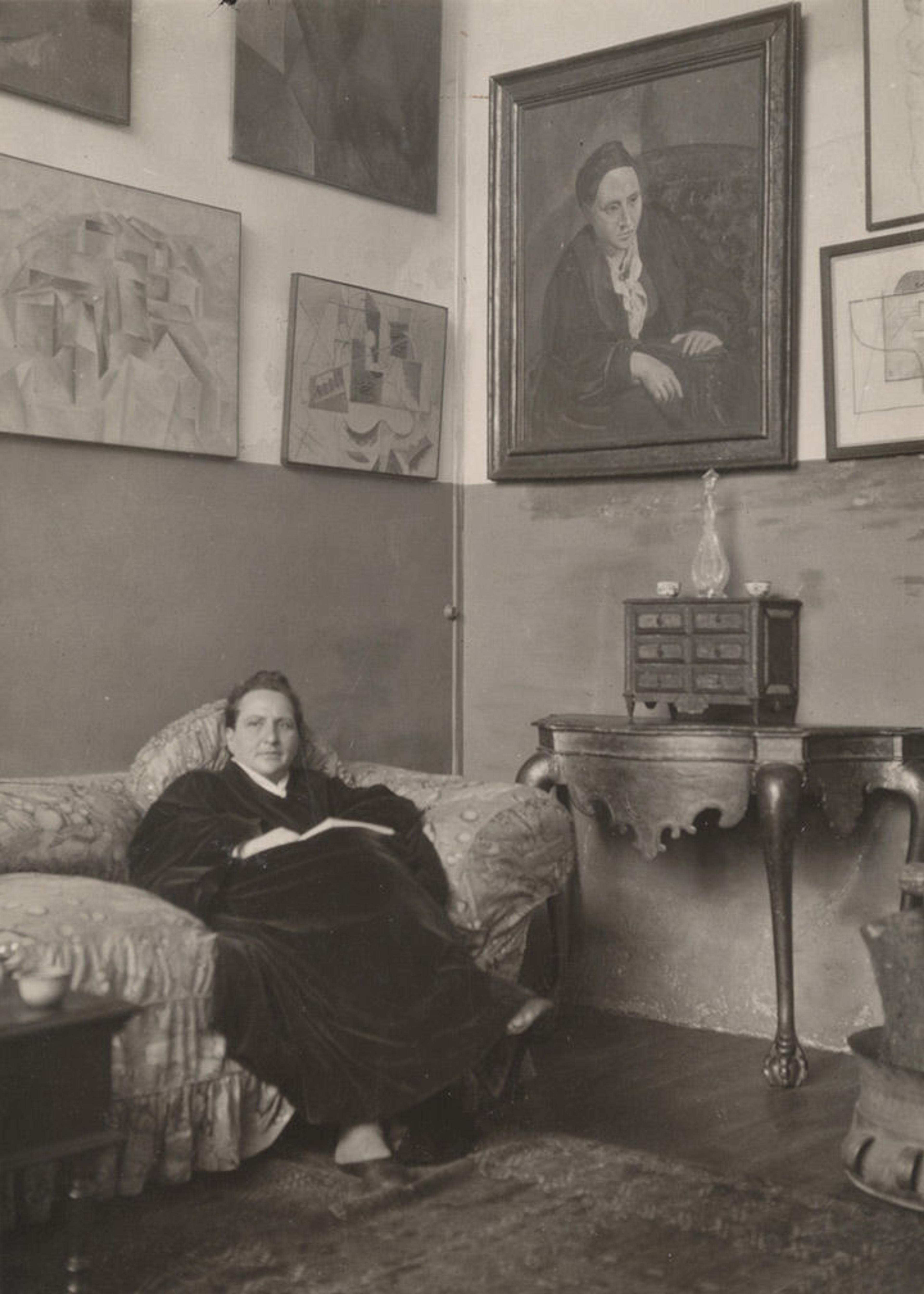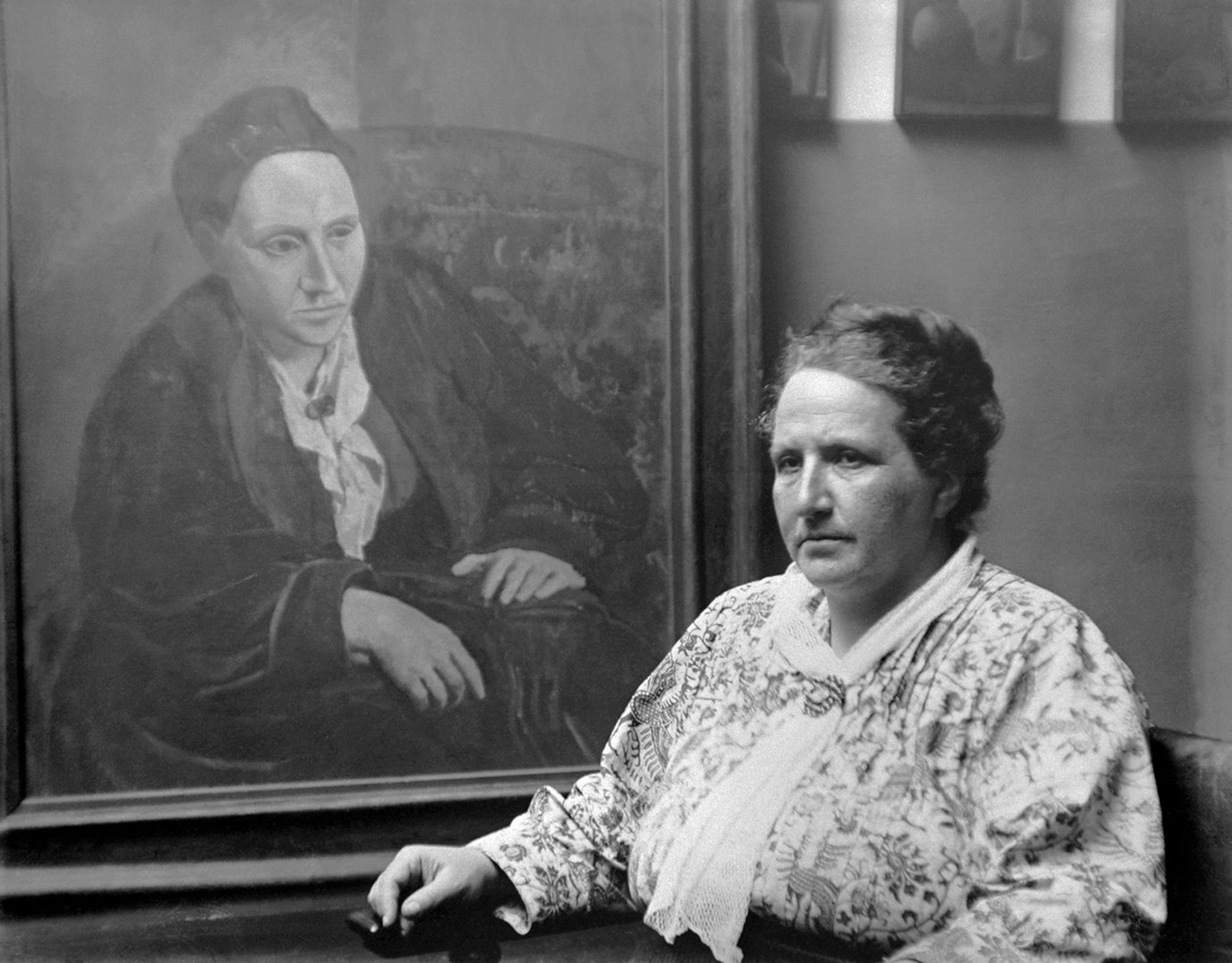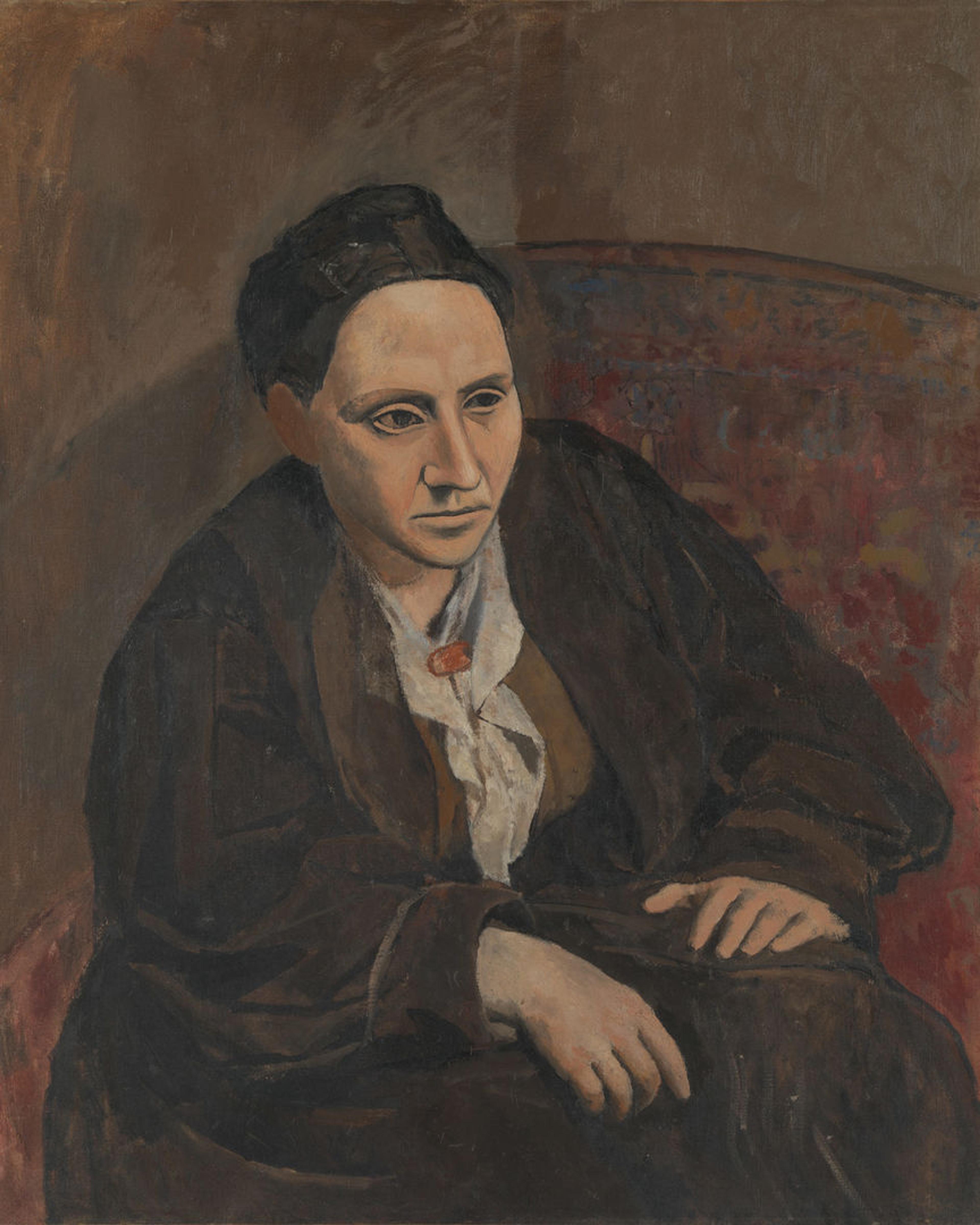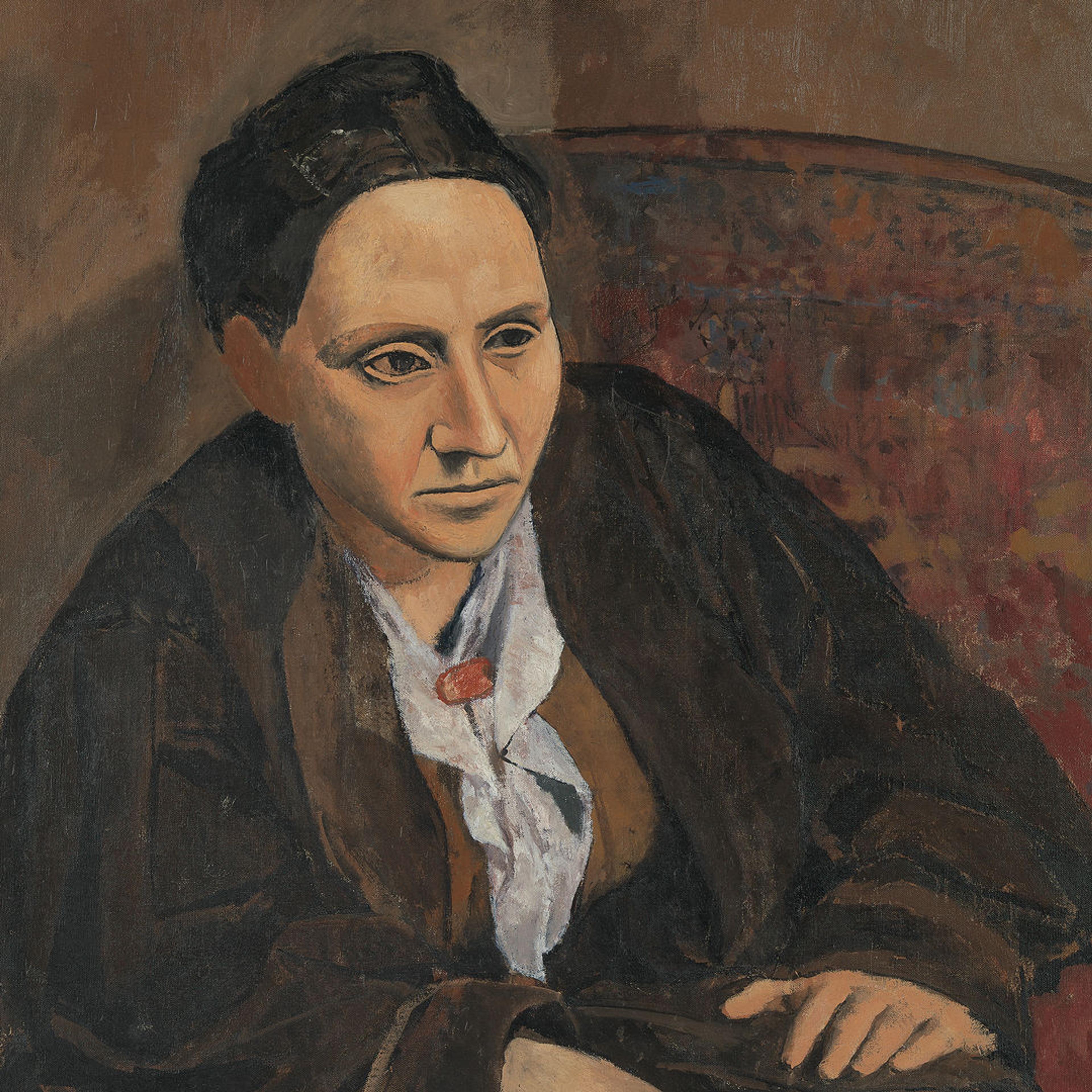The converted piano factory at 13 rue Ravignan was an unlikely site for the birth of modern art and literature. Picasso’s studio lay within a labyrinthine wooden building perched on the top of Montmartre hill in a notorious neighborhood popular with students, artists, and anarchists—a horse-drawn omnibus ride and a steep walk from Gertrude Stein’s home at 27 rue de Fleurus. The sound of children screaming, couples fighting, and impresarios singing bled through the thin walls, while tenants jostled for use of a solitary ground-floor bathroom. Inside his room, both light and heat were drawn from a rusty cast-iron stove in one corner opposite a single bed; the stench of paint mingled with the distinctive scent of Picasso’s energetic dog, Gat. Canvases were stacked against the wall, while the floor was scattered with pinched tubes of paint, fraying brushes, and jerricans oozing petrol.
In her autobiography, Stein remembered posing for hours in a broken armchair while Picasso sat opposite her on a small kitchen chair, inches from his easel, mixed brown and gray together on his palette, and laid brush to canvas. She described Picasso’s growing frustration over the months as he painted and scrubbed out her features, before reaching a total impasse, painting out the entire head in anger, and vanishing to Spain. On his return, without seeing her again, he painted the face back in, and presented the portrait to Stein as a gift. In the interval between first and second drafts, as she told it, Picasso’s style had undergone a seismic evolution: the original, naturalistic features were gone, and the face now resembled a sculptured mask, its features starkly outlined. When Stein protested that it didn’t look like her, he calmly replied, “It will.”

Gertrude Stein in her Paris studio with Picasso's portrait above her, unknown photographer, c. 1906.
When Stein was later asked how her portrait came to be painted by the relatively unknown twenty-four-year-old Picasso, she simply claimed that neither she nor the artist could remember. But—as was clear to visitors to the rue de Fleurus, where she held court over the subsequent decades from a chair placed directly underneath her likeness—it was central to her sense of identity. “For me,” she wrote in 1938, “it is I, and it is the only reproduction of me which is always I, for me.” The aura of mystery around the sittings—which Stein numbered at eighty or ninety, over the course of the winter of 1905–06—has turned the portrait into a myth. For Stein, it provided an origin story that would come to define her image, linking writer and artist indelibly as the two geniuses of the twentieth century: “Picasso in painting and I in literature.”
In The Autobiography of Alice B. Toklas (1933), and in the series of lectures she delivered in America in 1934 when that book became a bestseller, Stein placed herself—and her own literary “revolution” —at the heart of Picasso’s shift from the “charming early Italian period” of his pre-portrait work to “the intensive struggle which was to end in cubism.” “The rose period,” she wrote, “ended with my portrait.” From this point on, this was how she wanted to be recognized: not only as the instigator of the crucial swerve toward Cubism in Picasso’s art, but as an avant-garde artist who, as The Metropolitan Museum of Art put it some forty years later, “came to represent in literature what he stood for in painting—a constant search for new forms and a willingness to sweep out all that had gone before.”
For Stein, [the portrait] provided an origin story that would come to define her image, linking writer and artist indelibly as the two geniuses of the twentieth century.
As Picasso worked on her portrait, Stein recalled that she “meditated and made sentences” in her mind; she continued to ruminate walking home in the dark, before picking up a notebook and writing, furiously, through the night. The sittings coincided with the writing of her story “Three Lives,” a trio of novellas about working-class women in Baltimore. Rather than convey character through events and encounters, Stein sought to evoke, as closely as possible, her characters’ immediate experience: her writing unfolds in rhythmic cascades of simple, present-tense language, repeated over and over, heightening the reader’s alertness to variation in words and phrases, such that time appears to slow. She considered the book “the first definite step away from the nineteenth century and into the twentieth century in literature.” In her narrative, the sittings represented a radical departure for them both, setting each on a path toward the work that would, as she put it, “kill the nineteenth century.”
There was, of course, an ulterior motive. By the time Stein wrote her autobiography, in 1932, Picasso’s work was in high demand across the world, while hers languished in relative obscurity, consistently rejected by publishers and internationally mocked by readers. Already, Stein was looking toward her legacy, and facing down the fear that the work she considered her best was doomed to eternal repose in a filing cabinet. By representing their beginnings as intertwined, Stein was making a plea for their futures, too, to reach the same heights. In the will she prepared shortly before her death, in July 1946, Stein left two instructions for her executors: she wanted all her unpublished work to be printed, with funds to be raised from the sale of her art collection if necessary, while the Picasso portrait—the only artwork named in her will—was to be left to The Metropolitan Museum of Art, to ensure that her image would be kept in the public eye as long as Picasso’s work was admired.

Man Ray (American, 1890–1976). Gertrude Stein con un ritratto di Picasso, 1922. Gelatin silver print, 7 × 9 3/10 in (17.7 × 23.5 cm). © Man Ray 2015 Trust / Artists Rights Society (ARS), NY / ADAGP, Paris [2023]
The painting had moved with Stein and Toklas from the rue de Fleurus to the rue Christine in 1937; in September 1939, at the outbreak of war, Stein and Toklas had grabbed it along with a jumble of clothes and passports as they fled the city and brought it back six years later on a hair-raising taxi ride through the mountains. (When the car was stopped by armed officials, Toklas sternly reprimanded an officer who showed interest in examining their bundles, informing him that the Picasso painting was not to be touched.) It had not left their sight since its creation. Therefore it was perhaps unsurprising that when the president of the Paris Guaranty Trust arrived, in February 1947, to collect the portrait from Toklas on behalf of The Met, she begged to keep the portrait another week, as he explained in a cable to colleagues back in New York, to allow time for friends to say goodbye.
The short reprieve was granted. On February 23, 1947, Toklas led Picasso into the sitting-room, where his portrait still hung over the fireplace, facing the sofa where Stein always sat, such that Toklas used to imagine the two Steins talked to each other when no one else was there. “He stood alone in front of it quite a few minutes,” Toklas reported to her close friend, and Stein’s literary executor, Carl Van Vechten, “drinking it in as only his eyes can and then he saluted it quite seriously—quite simply—and he kissed my hand and said au revoir cherie. After all the portrait is their youth—its intensity and theirs are all one—and I mind its going so very very much.” As he left, Picasso shrugged and said to her, “Neither you nor I will ever see it again.”
Across the Atlantic, anticipation of the portrait’s arrival was fevered. “The rue de Fleurus will seem to live again,” wrote Van Vechten to Toklas. On August 22, the portrait was unveiled in The Met’s grand Fifth Avenue atrium, the only artwork displayed in the lofty hall, with a discreet plaque nearby telling the story of Stein and Picasso’s friendship. To the visitors who passed through the lobby or saw the portrait’s grainy reproduction in the evening newspapers, the display was a curiosity—an historical encounter between two familiar figures, a relic of bygone days. But to Toklas, now alone in Paris for the first time, the rupture felt “like another parting” from the woman to whom she had devoted her life.

Pablo Picasso (Spanish, 1881–1973). Gertrude Stein, 1905–6. Oil on canvas, 39 3/8 x 32 in. (100 x 81.3cm). The Metropolitan Museum of Art, New York, Bequest of Gertrude Stein, 1946 (47.106). © 2019 Estate of Pablo Picasso / Artists Rights Society (ARS), New York
Like Picasso, Stein had become a character of legend. Over the coming months and years, Toklas grappled with her new role as steward of Stein’s legacy, shepherding work into print, dealing with inquisitive biographers, granting (and refusing) permissions requests, battling to ensure the portrait remained on display at The Met, in the wake of an agreement between New York institutions that would have transferred it indefinitely to the Museum of Modern Art, an institution of which Stein disapproved. (“You can be a museum or you can be modern,” she wrote to its director Alfred Barr, “but you can’t be both.”) In her battle to cement Stein’s reputation as a great literary figure, not merely a personality, the portrait came to represent, for Toklas, both Stein’s enduring vitality and her ineffable absence. Yet its home at The Met placed her image in a dynamic new context. New York, in the 1950s and 1960s, was where many artists, poets, musicians, and dancers—from John Cage to the Judson Dance Theater, Frank O’Hara and the New York School to the anarchist ensemble of the Living Theatre—were beginning to read, respond to, and draw on her work, finding in it possibilities for their own boundary-defying art. If Paris was the artistic home of the first half of the twentieth century and New York that of the second, Stein was well placed to watch beatifically over two creative revolutions in which she played a significant role.
